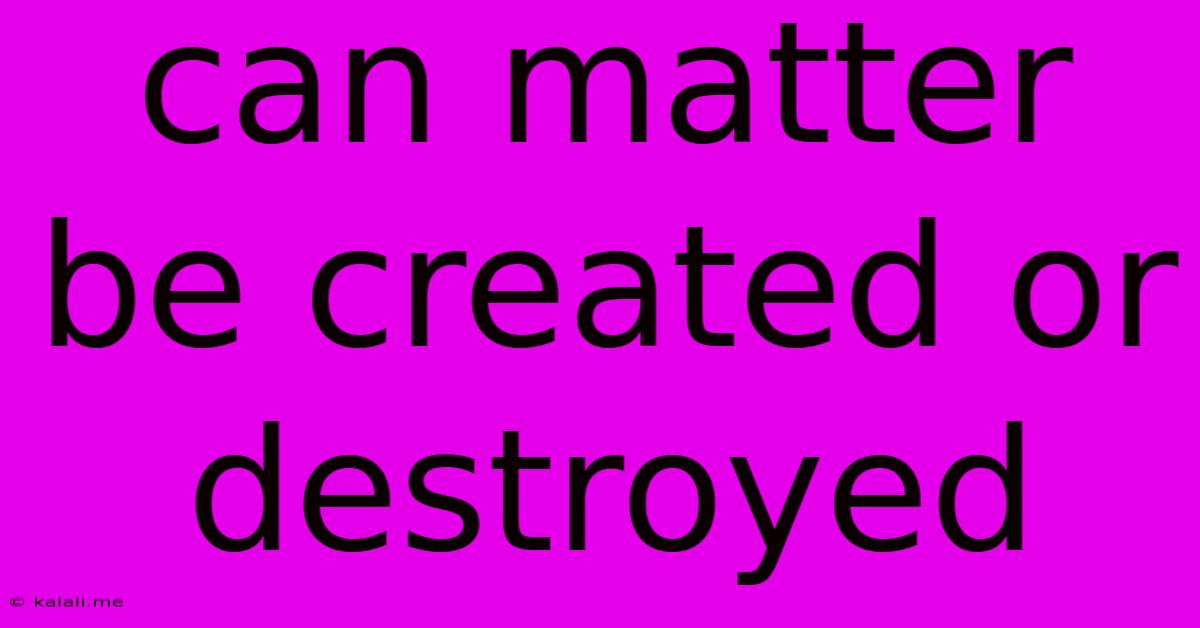Can Matter Be Created Or Destroyed
Kalali
May 23, 2025 · 3 min read

Table of Contents
Can Matter Be Created or Destroyed? Exploring the Laws of Conservation
The question of whether matter can be created or destroyed has puzzled scientists for centuries. The short answer, based on our current understanding of physics, is no. Matter cannot be created or destroyed, only transformed. This fundamental principle is enshrined in the law of conservation of mass, a cornerstone of classical physics, and its more comprehensive modern counterpart, the law of conservation of mass-energy. This article delves into these laws, exploring their implications and examining situations that might seem to contradict them.
Understanding the Law of Conservation of Mass
The law of conservation of mass states that in a closed system, the mass of the system remains constant over time. This means that matter cannot be created or destroyed, only changed from one form to another. For example, when wood burns, it appears that mass is lost as ash is significantly lighter than the original wood. However, the mass isn't actually destroyed; it's transformed into gases like carbon dioxide and water vapor, which escape into the atmosphere. If you could meticulously collect all the products of combustion – the ash, gases, and even the heat released – you would find that the total mass remains the same as the original wood. This principle was crucial in the development of early chemistry, allowing scientists to accurately balance chemical equations and predict the outcomes of reactions.
The Limitations of Classical Conservation of Mass
The law of conservation of mass, while incredibly useful, isn't entirely accurate in all situations. It breaks down at extremely high speeds or energies, where relativistic effects become significant. This led to the development of a more complete and accurate law.
Introducing the Law of Conservation of Mass-Energy
Einstein's famous equation, E=mc², revolutionized our understanding of mass and energy. This equation demonstrates the equivalence of mass and energy: mass can be converted into energy, and energy can be converted into mass. This led to the formulation of the law of conservation of mass-energy, which states that the total amount of mass and energy in a closed system remains constant over time. This law encompasses the law of conservation of mass as a special case, applicable when relativistic effects are negligible.
Examples of Mass-Energy Conversion
Nuclear reactions, such as nuclear fission and fusion, provide compelling examples of mass-energy conversion. In nuclear fission, a heavy atom like uranium is split into smaller atoms, releasing a tremendous amount of energy. The mass of the resulting smaller atoms is slightly less than the original uranium atom – this "missing" mass is converted into energy according to E=mc². Similarly, in nuclear fusion, lighter atoms combine to form heavier atoms, again releasing a significant amount of energy, with a corresponding reduction in mass.
Particle Physics and Matter Creation
While the law of conservation of mass-energy holds true in our macroscopic world, particle physics presents a seemingly contradictory scenario. In particle accelerators, high-energy collisions can create new particles from energy. This appears to violate the law, but it doesn't. The energy used to create these particles is converted into mass, adhering to E=mc². The total mass-energy of the system remains constant; energy is simply transformed into new forms of matter.
Conclusion
While it might seem counterintuitive, the creation of new particles from energy in particle accelerators doesn't violate the law of conservation of mass-energy. It simply highlights the deep connection between mass and energy. In essence, matter can't be created or destroyed ex nihilo. It can, however, be transformed from one form to another, and its mass can be converted into energy and vice versa, always preserving the total mass-energy within a closed system. This fundamental principle remains a cornerstone of modern physics, governing everything from chemical reactions to the processes occurring within stars.
Latest Posts
Latest Posts
-
Can You Bring A Water Bottle On A Plane
May 23, 2025
-
Are Yellow Potatoes The Same As Yukon Gold
May 23, 2025
-
How To Get Olive Oil Out Of Clothes
May 23, 2025
-
Does Vbos Increase Fps Witha Good Gpu
May 23, 2025
-
How Did Howard Find Out Jimmy Throw The Bowling Balls
May 23, 2025
Related Post
Thank you for visiting our website which covers about Can Matter Be Created Or Destroyed . We hope the information provided has been useful to you. Feel free to contact us if you have any questions or need further assistance. See you next time and don't miss to bookmark.